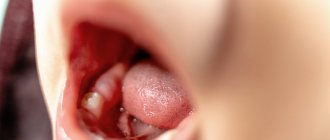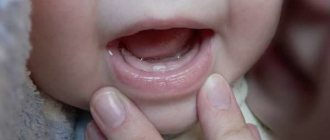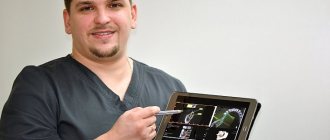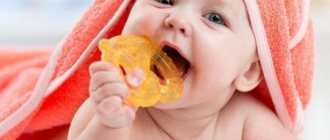Many parents are mistaken, thinking that baby teeth do not need care, which will fall out anyway, and therefore are in no hurry to show their baby to the dentist. In fact, the health of permanent teeth in the future directly depends on proper care of baby teeth.
Temporary, or baby, teeth begin to emerge in babies at the age of 6–8 months. First the two lower central incisors, and then the two upper ones. By 8–12 months, the lateral incisors appear alternately on the lower and upper jaws. At the age of 12–16 months, the first chewing teeth (molars) hatch, and at 1.5–2 years, the canines. At 2.5 years, the second chewing teeth emerge. Thus, by the age of 2.5–3 years, the child should have a full set of 20 teeth.
The ancient physician Hippocrates called temporary teeth milk teeth. He was sure that the building material for them was calcium contained in mother's milk.
Goodbye dummy
The less time remains before the tooth appears, the more anxious the baby becomes: nervous, cries, sleeps poorly, and sometimes has a fever. The parents’ task is not only to alleviate his suffering, but also to show him to the pediatric dentist. The doctor will evaluate how the process is going and give recommendations for oral care. If the gums are swollen, which, however, is a normal phenomenon during teething, he will prescribe special hygiene products, such as a gel or spray. The plant extracts they contain have an anti-inflammatory and anesthetic effect with a slight freezing effect. By the way, there will also be special toys with relief designs applied to them - with them the baby can scratch his gums to his heart's content - and a teething ring with water inside for cooling and to relieve pain. But the toddler will have to part with the pacifier; it can cause the formation of an incorrect bite.
Malocclusion is another common problem with children's teeth. Often a pathological bite develops at a very young age, especially in those children who are bottle-fed. This is due to the fact that when breastfeeding, the child’s lower jaw works well, but when feeding from a bottle, the baby does not need to make any effort and the facial muscles work poorly. When the chewing apparatus does not work enough, this leads to insufficient development of the bones of the lower and upper jaw, which can subsequently affect the condition of the bite. Various bad habits of the baby, such as thumb sucking or prolonged sucking on a pacifier, have a very bad effect on the bite. It is advisable to wean your baby off the pacifier from the age of 9 months, and it is better not to allow thumb sucking.
If a child has developed a malocclusion, the orthodontist may recommend correcting it at the age of 6-7 years. In some cases, to correct the bite, you simply need to undergo a course of special gymnastics and massage. If the installation of braces is necessary to correct the bite in children, then they are installed for a much shorter period than in adults.
Text of the book “Fundamentals of clinical dental morphology: a textbook”
As the enamel develops further, the enameloblasts decrease in size and move away from the dentin. Some enameloblasts die by apoptosis and are phagocytosed by neighboring cells. By the time teeth erupt, anameloblasts sharply decrease and are reduced, and the enamel is covered only with a thin shell - the secondary enamel cuticle, formed by cells of the outer enamel epithelium, collapsed pulp and an intermediate layer of the enamel organ, which covers the enamel and plays a protective role.
The process of enamel mineralization, starting in the area of the cutting edge and chewing tubercles of the teeth, then moves to other surfaces. The use of a new radiography method with primary direct image magnification [Belova N.A., 1981] showed that at 18–19 weeks of intrauterine development, signs of mineralization of the incisal edge and the surfaces of the incisor crowns by one third are clearly visible, as well as the beginning of calcification of the incisal edge of the canines and the vestibular medial cusp of the first molars.
At 24–25 weeks (6 months), mineralization of the incisors continues, the cutting edge of the canine is almost completely calcified, and points of calcification of the lingual medial tubercle of the first molars appear.
At 26 weeks (7 months), calcification of the incisors and canines continues, the vestibular cusps of the first molars have almost fused, and the first signs of mineralization of the apex of the distal vestibular cusp of the second molar are visible.
At 32 weeks (8 months), calcification of the incisors and canines continues; The vestibular cusps of the first molars merge.
At 36 weeks (9 months), all surfaces of the incisors are calcified (except for the cervical region), the vestibular cusps of the first molars are completely fused, the lingual cusps of the first molars are more clearly visible, and mineralization of the lingual distal cusp of the second molar is more intense.
After the birth of a child, the cervical area of the incisors becomes calcified; cervical region, vestibular and proximal surfaces of the canines, as well as the lingual surface of the first primary molar.
The final maturation of enamel (tertiary mineralization) occurs after tooth eruption, especially intensively during the first year of a child’s life. The main source of inorganic substances entering the enamel is saliva and, to some extent, dentin.
The study of the processes of development and calcification of enamel is not only of theoretical interest.
It is necessary for a correct understanding of the mechanism of development of a number of pathological processes that are observed in the enamel of developing or already completed teeth (enamel hypoplasia, caries). 6.2.3.
Development of the tooth root and cementum The development of the tooth root occurs already in the postnatal period, shortly before eruption. By that time, the crowns of baby teeth are mostly already formed. On top of the enamel layer of the tooth crown are the remains of the enamel organ in the form of an epithelial layer consisting of several rows of cells. This reduced enamel epithelium remains on the surface of the tooth crown until its eruption and, as some authors believe [48, 72], prevents the resorption of enamel from the connective tissue of the jaws or the deposition of cement on its surface.
These regressive changes in the enamel organ do not affect its edges, where the inner enamel cells merge into the outer enamel epithelium. The cells here actively proliferate, forming the epithelial (Hertwig) root sheath (vagina radicalis epithelialis), which plays an important role in the formation of tooth roots (Fig. 134). this vagina consists of inner and outer enamel organ cells closely adjacent to each other.
Rice. 134. Formation of the root of a growing tooth.
1 – epithelial root sheath; 2 – root dentin; 3 – root cement; 4 – dental pulp; 5 – epithelial diaphragm; 6 – epithelial bodies of Malasse; 7 – dental alveolus.
The inner enamel cells remain cubic in shape and do not develop into anameloblasts. The pulp of the enamel organ and its intermediate layer are absent. the epithelial vagina forms around the dental papilla, at its base, a kind of ring - the diaphragm (see Fig. 134, A) of the root sheath (diaphragma vaginae radicis), which gradually grows into the underlying ectomesenchyme, separating that part of it that will go to the formation of the tooth root .
The mesenchymal cells of the dental papilla, adjacent from the inside to the epithelial root sheath, turn into odontoblasts, which form root dentin (see Fig. 134, B). After the appearance of root dentin, the epithelial sheath grows with the cells of the dental sac, loses its continuity and is subsequently resorbed. Some vaginal cells may remain in the periodontium of an adult tooth in the form of residual epithelial Malasse bodies (see Fig. 134, B).
As a result of the disintegration of the epithelial root sheath, the ectomesenchymal cells of the dental sac come into direct contact with the root dentin, differentiating into cementoblasts, which begin to deposit cement on the surface of the root dentin.
The differentiation of ectomesenchymal cells of the dental follicle into active cementoblasts is accompanied by the development of granular endoplasmic reticulum, the Golgi complex, and a system of microbubbles and vesicles in the cells. First, cementoblasts synthesize internal collagen fibers of the extracellular matrix. The collagen released from the cells is further modified by specific non-collagen proteins, also derivatives of cementoblasts, into a form capable of calcification.
During cement mineralization, cementoblasts are constantly separated from the hardening front by a layer of non-calcified cement - cementoid, or precement. In addition to collagen, the cementum contains processes of cementoblasts. In some cases, cementoblasts are surrounded by their own excretory products, which harden, turning cementoblasts into cementocytes. The latter are an inactive form of dental follicle cells that lose organelles for protein synthesis and subsequently die, turning into scaly formations.
It is interesting to note that, unlike bone or dentin, the initial hardening of cementum does not depend on the activity of extracellular mineralized matrix vesicles, but occurs to some extent by the spread of hydroxyapatite from the dentin of the tooth root.
The rest of the dental sac, surrounding the developing tooth root, gives rise to the dense connective tissue of the pericement (periodontal). Bundles of collagen fibers of the pericementum with some of their ends are, as it were, soldered into the ground substance of the developing cement, and with the other ends they pass into the ground substance of the alveolar bone. As a result, the root is tightly strengthened in the dental alveolus.
In general, the formation of cement occurs according to the type of periosteal osteogenesis. The resulting cement is almost coarse-fibrous bone tissue in structure, covering the outside of the root dentin.
Exposure to unfavorable factors during cementogenesis can lead to hypercementosis (cement hyperplasia). The process can affect one or all teeth. Hypercementosis is also possible in certain areas of the root of one tooth.
In some cases, loose nodular thickenings of hardened cement form in the periodontal membrane. Such thickenings are known as cementicles. They are usually observed around degenerated epithelial remnants of Hertwig's vagina. With age, cementicles may adhere to the cementum, forming centers of localized excementosis.
After the formation of the root, the epithelial root sheath stops growing in depth, gradually closes in a ring shape and forms an opening at the apex of the tooth root, through which the vessels and nerves of the dental pulp pass. The initially wide apical opening of the root canal gradually narrows due to the deposition of new masses of dentin and cement.
Root development is more difficult in multi-rooted teeth. Depending on the type of tooth, the initially single and wide root canal of such teeth is divided into two or three canals. From the edges of the diaphragm of the epithelial root sheath, two (in the rudiments of the lower molars) or three (in the rudiments of the upper molars) epithelial outgrowths grow towards each other in a horizontal direction. The apices of these outgrowths eventually grow together and the initially single cervical opening is divided into two or three openings, according to the number of future roots. Their further development proceeds similarly to that of single-rooted teeth.
The growth of the roots of baby teeth and their subsequent resorption occur in a certain order. Thus, the roots of the central incisors and first molars develop during the first six months of a child’s life. Root growth continues until the age of 2–2.5 years, after which their gradual resorption occurs. The roots of the lateral incisors begin to develop during the first half of the year and grow until 2 years. Their resorption begins at the age of 5–6 years. The roots of the fangs develop in the period from 1 year to 3.5 years, and are resorbed in the 5th year.
The development of the roots of second molars occurs within 11.5 years.
By the age of 3, the roots are fully formed. Their resorption begins at the age of 5 years. 6.2.4.
Development of the pulp of primary teeth Simultaneously with the histogenetic processes of formation of dental tissues, differentiation of the mesenchymal elements of the dental papilla occurs in its central part.
Mesenchymal cells increase in size and begin to move away from each other due to the appearance of a basic amorphous substance between them. Gradually, the mesenchyme of the papilla is transformed into loose connective tissue, rich in fibroblasts, fibrocytes and macrophages, as well as blood vessels and nerves. By the time the tooth erupts, the mesenchyme of the papilla is almost completely differentiated into the pulp of the dental organ, although the final restructuring of the tissue elements of the pulp is completed in the first years of life. 6.2.5.
Eruption of baby teeth Eruption of a tooth is the process of its movement from its origin and development within the jaw until a crown appears in the oral cavity. This tooth movement is a complex, multifunctional stage in tooth development, as it is accompanied by coordinated changes in the growth of teeth, alveolar processes and the jaws themselves. During the period of eruption, developing teeth make movements in various directions, among which the following can be distinguished:
– vertical (axial) movement in the direction of the long axis of the tooth;
– movement in the distal, mesial, lingual or vestibular direction (change in position in the jaw);
– wedging (lateral movement);
– rotation – movement around the longitudinal axis of the tooth.
All these movements make it possible to maintain constant the relationship of the tooth germs to the edge of the developing alveolar process of the jaw, which is a necessary condition for the successful completion of tooth eruption. During eruption, the tooth makes a significant journey in the jaw, during which the following are observed:
– changes in the tissues surrounding the tooth;
– tooth root development;
– restructuring of the alveolar bone;
– development and restructuring of the periodontium.
In the connective tissue of the gums, which lies in the path of movement of the erupting tooth, regressive changes occur due to the pressure of the tooth on the tissue. These changes cause ischemia (malnutrition) and subsequent tissue atrophy and resorption. The reduced enamel epithelium covering the tooth crown (formed by the outer and intermediate layers of the enamel organ, as well as enameloblasts that have completed the production of enamel) secretes enzymes that also contribute to the destruction of the connective tissue separating it from the epithelium of the oral cavity. Approaching the epithelium lining the oral cavity, the enamel epithelium proliferates and subsequently merges with it. The epithelium of the oral cavity above the crown of the tooth degenerates and through the resulting hole the crown erupts into the oral cavity, while there is no bleeding, since the crown moves through the canal lined with epithelium (Fig. 135).
Having penetrated the oral cavity, the crown continues to erupt until it takes its final position in the chewing plane, meeting the crown of its antagonist.
The reduced enamel epithelium remains attached to the enamel of the unerupted portion of the crown, where it is called the primary attachment epithelium. It is subsequently replaced by secondary attachment epithelium, which is part of the gingival epithelium.
Rice. 135. Eruption of baby teeth.
1 – epithelium of the oral cavity; 2 – tooth cuticle; 3 – erupting tooth; 4 – gingival epithelium; 5 – dental alveolus.
Regressive changes in the connective tissue surrounding the erupting tooth occur simultaneously with the intensive development of its root due to odontoblasts producing dentin and ectomesenchymal cells of the dental sac, differentiating into cementoblasts that deposit cement on top of the root dentin. At the same time, growth of periodontal fibers and restructuring of the alveolar bone are observed. Intense deposition of bone tissue in some areas is combined with its active resorption in others. The severity of these changes varies throughout the entire period of eruption and is not the same in different teeth.
Deposition of bone tissue occurs, as a rule, in those areas of the bone socket from which the tooth is displaced, and in the areas towards which the tooth migrates, resorption is observed. Resorption of bone tissue makes room for the growing tooth, reducing resistance to its movement. Bone deposition usually manifests itself as the formation of bony trabeculae separated by wide spaces.
In the incisors, areas of increased deposition of bone beams are the bottom and lingual surface of the alveoli, which indicates a displacement of these teeth towards the lips during eruption.
Bone tissue in premolars and molars is deposited on the bottom and distal walls of the dental cell, which indicates their additional medial displacement during axial movement during eruption.
In multi-rooted teeth, the deposition of bone beams occurs most intensively in the area of the future interradicular septum.
The main periods of laying, formation and eruption of milk teeth are reflected in the table. 3.
Table 3
Timing of formation, formation and eruption of baby teeth in humans
Note:
i/w – period of intrauterine life.
6.2.6.
Development and eruption of permanent teeth The development of permanent teeth occurs in the same way as the development of primary teeth, but more slowly (Table 4).
Table 4
Timing of the formation, formation and eruption of permanent teeth in humans
Note:
i/w – period of intrauterine life.
The source of their formation is the same dental plate from which the rudiments of milk teeth developed. Starting from the 57th month of prenatal development, along the free edge of the dental plate (some scientists propose to call these sections of the dental plate the replacement dental plate), behind each baby tooth germ, on the lingual side, the enamel organs of the anterior permanent teeth are formed: incisors, canines and premolars. Since there are no premolars in the child’s primary dentition, the primary molars are subsequently replaced by permanent premolars.
In the prenatal period, the rudiments of the incisors (6-7th month) and canines (7-7.5 months), and then the premolars (7.5 months), are formed first from the group of anterior permanent teeth in the prenatal period. As a result, 10 rudiments of replacement permanent teeth appear in each jaw of the embryo.
Initially, the rudiments of these teeth lie in the bone alveoli common with the rudiments of milk teeth, but then a bone septum grows between them and a gradual separation of the cells of milk and permanent teeth occurs.
At the same time, the dental plate continues to grow posteriorly in each jaw and along its edge the enamel organs of large molars are formed (it is believed that these teeth should also be embryologically classified as the generation of milk teeth, rather than permanent teeth).
The earliest appearance of the first molar rudiment is in the 56th month of intrauterine life. The formation of the remaining molars occurs after birth: the rudiment of the second molar appears in the 5-6th month of a child’s life, and the rudiment of the third molar - in the 5-6th year of life, which is probably associated with the growth and elongation of the jaws. As they grow, the dental plates lengthen and grow posteriorly, the ends of which are displaced in the lower jaw into its branch, and in the upper jaw into the maxillary tubercle. This is where the enamel organs of the second and third permanent molars are formed. Only after this the dental plate gradually resorbs and disappears.
The very development of permanent teeth and differentiation of dental tissues occur in the same way as milk teeth. Ectomesenchyme grows into the enamel organs of permanent teeth from below and a dental papilla is formed. In the circumference of the germ of permanent teeth, a dental sac is formed from the ectomesenchyme and the further development of permanent teeth proceeds in the same way as milk teeth. The difference lies only in the time of passage of individual stages and the longer development of permanent teeth (about 10 years), especially large molars. Thus, during the period when milk teeth go through the last stages of their development, the jaws already contain the laying of permanent teeth that are at earlier stages. Therefore, in a child aged 3 to 6–7 years, an X-ray examination can reveal from 48 to 52 teeth in both jaws, of which 20 (baby teeth) perform their function, and the rest are still at various stages of development.
Calcification of the rudiments of permanent teeth is not observed before birth, with the exception of the first molar. A point of calcification in one of the cusps of the crown of this tooth appears on
9th month of intrauterine life. Complete crown formation occurs by two years. Calcification of the incisors begins in a child by 3–4 months. Complete crown formation occurs in the central incisors at 2–2.5 years, and in the lateral incisors by 3 years. Fangs begin to calcify at 4–5 months of age, and crown formation ends at 4–4.5 years. The process of mineralization of small molars begins at the end of the 2nd – beginning of the 3rd year of a child’s life and ends by 6–7 years. The beginning of calcification of the second molars dates back to 45 years. The third permanent molars calcify by 1315.
The formation of the roots of the medial incisors begins at the age of 3–3.5 years, the lateral incisors at the age of 4–4.5 years, the canines at the age of 5.5–6 years, and the first molar at the age of 4–6 years. The roots of the medial incisors reach full development at the 9-10th year, the lateral ones - at
10–11 years, canines by 12–15 years; premolars - by 12-14 years, first molars - at 9-10 years, second - at the age of 14-16 years, third molar - from 18 to 25 years.
At the age of 6–8 years, permanent teeth begin to erupt. The first large molar erupts first, then the medial and lateral incisors appear, then (from 9 to 14 years) the premolars and canines, as well as the second molar and the third molar later (at the age of 18–25 years, sometimes later).
The process of eruption of permanent replacement teeth is accompanied by the loss of milk teeth. During this period, resorption occurs first of the dental alveoli, and subsequently of the roots of the teeth (Fig. 136).
Rice. 136. Development and eruption of primary and permanent teeth.
1 – primary incisor; 2 – gums; 3 – rudiment of the permanent incisor; 4 – bone alveolus.
As the permanent tooth begins its vertical movement in the jaw, it puts increasing pressure on the alveolar bone surrounding the primary tooth. In the connective tissue separating the alveolus of a baby tooth from the crown of a permanent tooth, giant multinucleated cells—osteoclasts—differentiate, which actively resorb bone tissue.
After the destruction of the alveoli in the process of ongoing vertical movement, the permanent tooth begins to exert pressure now on the root of the baby tooth. Around the latter, osteoclasts (odontoclasts) also differentiate from the connective tissue, which actively resorb the tissues of the baby tooth.
Odontoclasts are located on the surface of the tooth root in wide lacunae. They are large in size, with numerous outgrowths of the cytoplasm on the side facing the root, containing a large number of lysosomes and mitochondria.
The destruction of primary tooth root tissues (dentin and cementum) by odontoclasts includes their demineralization, phagocytosis of areas and their intracellular digestion. The localization of the initial sites of root resorption depends on the location of the anlage of the replacement teeth: in primary incisors and canines it begins in the apical region on the lingual side, in primary molars - on the interradicular surface. Cells of the pulp of the baby tooth also participate in this process, from which odontoclasts also differentiate, destroying predentin and dentin from the pulp side of the tooth.
The process of resorption of the roots of baby teeth begins long before the eruption of the corresponding permanent teeth and proceeds very slowly and in waves: periods of increased resorption are followed by periods of rest. During the latter period, cementoblasts or fibroblasts appear in the tissues, the activity of which leads to the partial development of reparative processes - the deposition of cement or bone-like tissue on the surface of destroyed dentin.
The amount of resorbed tissue is usually greater than that of newly formed tissue. Therefore, the process of destruction of the baby tooth progresses, which ultimately leads to the loss of connection between the tooth and the alveolar wall and the empty crown being pushed into the oral cavity. This crown usually falls out under the influence of a growing permanent tooth, chewing forces, or a slight mechanical impact on it.
Loss of primary teeth typically occurs symmetrically on the right and left sides of each jaw, and occurs faster in girls than in boys. With the exception of second molars, primary teeth in the lower jaw fall out earlier than the corresponding teeth in the upper jaw.
The eruption mechanism is generally similar in permanent and baby teeth. According to a number of authors, the eruption of permanent replacement teeth is facilitated by the presence of a special anatomical structure - a conductive channel, or cord. The anlage of such a permanent tooth is initially located, as noted, in the common bone alveolus with the milk tooth. Subsequently, it is completely surrounded by alveolar bone, with the exception of a small narrow canal containing the remains of the dental plate and connective tissue. Together, these structures are called the conductive cord, which contributes to the directional movement of the permanent tooth during its eruption.
The eruption of additional permanent teeth (large molars) is not accompanied by destruction of the roots of milk teeth, since they do not have predecessors, but occurs in the same way as ordinary milk teeth.
The first permanent teeth to erupt are the first molars, usually on the lower jaw first; behind them are the medial incisors, lateral incisors, first premolars, second premolars and canines, second molars and finally third molars (wisdom teeth).
Full development of the roots of these teeth is completed within 2–3 years after eruption. Thus, the process of replacing baby teeth with permanent ones lasts for 14–17 years. Therefore, at approximately 5–6 years of age (from 6 to 12 years), a mixed set of teeth is observed in the child’s jaws.
The views on the explanation of the biomechanics of teething by various authors are ambiguous. There are a number of theories of teething: the theory of tooth root growth, the theory of increasing hydrostatic pressure in the dental pulp and in the periapical region, the theory of bone tissue remodeling, the theory of periodontal traction, etc. [5].
According to the root growth theory,
the process of eruption is the result of the tooth being “pushed” out of the alveolus by the growing root. From the perspective of this theory, the eruption of a tooth with an unformed root, the complexity of the trajectory of the tooth before eruption begins, as well as the lack of resorption of the bone tissue of the dental alveolus, which opposes the root apex, are inexplicable.
The theory of increasing hydrostatic pressure in the dental pulp and in the root apex area
involves the participation in the mechanisms of tooth eruption in the process of increasing the volume of the pulp in the direction of eruption, as well as increasing blood supply and vascular permeability in the area of the root apex.
According to the theory of bone tissue remodeling
The direction of tooth movement during eruption is determined by the direction of bone tissue growth in the area of the bottom of the dental alveoli and its resorption from the opposite side. From the standpoint of this theory, it is difficult to exclude the transformation of bone tissue as a consequence of tooth eruption itself.
Periodontal traction theory
provides for the dependence of the eruption process primarily on the formation of periodontium, the development of which is accompanied by a stop in tooth eruption.
Apparently, each of the existing theories of tooth eruption reflects one of the aspects of this complex process.
Beware of caries!
The second meeting with the dentist should take place no later than the last tooth erupts. It is very important! Permanent teeth are located at the very roots of baby teeth. And if you do not prevent the disease of temporary ones, you can disrupt the process of formation of permanent ones. In addition, the presence of putrefactive pathogenic bacteria in the mouth not only reduces the child’s immunity, but also increases the risk of viral diseases, diseases of the upper respiratory tract and gastrointestinal tract.
If by the age of two or three years the baby’s teeth are in perfect order, an appointment with the dentist will take no more than half an hour. The doctor will assess the condition of the teeth, the formation of the bite and determine the date of the next appointment. However, the latest medical data from dentists suggests that it is at this age that the carious process begins in most children. In the youngest, the main reason for its appearance is hidden in a bottle of sweet water, formula or juice, which caring mothers give at night. During sleep, salivation, which cleans the teeth, stops, swallowing stops, and the sweet plaque remains on the teeth throughout the night. And this is an excellent environment for the development of microorganisms and the occurrence of so-called bottle caries. The painful process proceeds so quickly that in a matter of months the enamel becomes covered with white spots, becomes porous, holes form on it, and the tooth quickly collapses.
In children over three years of age, the source of caries also lies in excessive consumption of sweets. Carbonated drinks, chewing gum and sucking candies are the main culprits of the disease. Another common cause of the disease is lack of oral hygiene and poor diet.
It doesn't hurt at all
Many parents put off their child’s meeting with the dentist for a completely obvious reason: adults have a fear of this office since childhood. But today dentistry is completely different. And a visit to the dentist becomes more of an exciting game for a child. In the doctor's office there are beautiful toys, sketchbooks, and favorite children's cartoons - the child can watch them even during the examination. In some clinics, the baby is allowed to “participate” in the treatment, for example, choose a filling of the color he likes.
ON A NOTE. In order for a child to never be afraid of the dentist, it is important to set it up correctly even before visiting the doctor. Never frighten a child with a dentist, do not mention your unsuccessful examples of visiting a doctor in front of your child, if you yourself are very worried, try not to show your emotions, children very easily feel the mood of their parents. Many children's dental clinics have specially designated areas for children's games; try to keep your child busy with games while waiting for their turn. If you have been prescribed a very long course of treatment, you can divide it into several stages so that the child does not get tired.
A child can remember the first feeling of pain in a dental office for the rest of his life. To prevent this from happening, doctors use local or general anesthesia and even pre-treat the injection site with an anesthetic spray or gel. Thus, dental treatment does not cause any unpleasant sensations in the child. To treat children's teeth, other instruments, materials and medications are used that are not used to treat permanent teeth. When choosing a pediatric dentist for your child, you can rely on reviews from other patients. In a good children's dental clinic, the rooms are equipped with the most modern technology, which allows you to treat children's teeth silently and painlessly.
If the disease is not advanced and caries has affected only the surface layer, the teeth are simply silvered - this is an old and well-tested method of treating teeth without a drill. But it has a significant drawback: the black silver salts that fall out during the reaction leave dark spots on the enamel. Therefore, silvering is currently giving way to remineralizing therapy. In this case, the teeth are coated with a special composition that saturates them with fluoride, closes the affected crystal lattice of the enamel and allows you to stop the process. The natural color of the enamel is not lost.
If the destruction goes deeper, a filling is placed. Treatment is carried out under general anesthesia. When the caries damage is so large that a simple filling cannot withstand the load, the doctor uses metal or plastic crowns as a temporary measure. Their main task is to preserve the baby tooth until it is replaced with a permanent one.
The saddest verdict of the dentist: the tooth needs to be removed. The measure is necessary in two cases: when the tooth is severely damaged or when the milk tooth goes out of the natural loss schedule and prevents the permanent tooth from erupting.
After removal, a special plate is installed under general anesthesia, which compensates for the defect in the dentition and prevents further deformation and malocclusion.
Of course, removing baby teeth is a last resort, as this can lead to serious problems. Firstly, to improper development and deformation of the jaw, which in the future is fraught with bite pathology. Secondly, the absence of a tooth disrupts the process of chewing food and diction. Timely prevention and proper dental care will help you avoid serious problems. Therefore, it is recommended to show the baby to a specialist at least once every four months.
Permanent teeth appeared too early or late
It should be noted that due to the manifestation of acceleration processes, the timing of the eruption of permanent teeth has changed somewhat. Permanent teeth began to emerge earlier, at least 6-8 months. Often, already at the age of five, a child has a mixed dentition, in which the first permanent molars and central incisors are already emerging.
The timing of teething is influenced by both local and general factors.
Local:
- injury,
- premature removal of a temporary tooth,
- edentia,
- tooth retention,
- congenital clefts.
If there is no germ of a permanent replacement tooth or if its position is incorrect, there is no pressure on the bone septum separating it from the roots of the temporary tooth. This leads to a lack of activity of osteoclasts, the cells responsible for root resorption.
Are common:
- heredity,
- genetic factors
- endocrine pathology
- general health.
In particular, with diseases of the thyroid gland, as a result of an imbalance in the mineral balance in the body, there is a delay in the eruption of teeth, both temporary and permanent occlusion. Thus, with hypothyroidism, there is a delay in the eruption of milk teeth by 1-2 years, permanent teeth by 2-3 years.
In general, more and more pediatric dentists and pediatricians are noticing significant differences in the timing and sequence of teeth eruption of temporary and permanent dentition in children. Teething is a multifactorial process. The timing of teething is influenced by race and the general health of the body. None of the currently existing theories fully provides an answer to the mechanisms of teething.
Indisputable, according to many domestic and foreign pediatric dentists, is the fact that the eruption of both temporary and permanent teeth in today’s generation of children occurs earlier than average by at least 6-8 months.
Regular dental checkups will help you avoid serious dental problems.
The pediatric dentist and orthodontist closely monitor the development of the child’s dental system, providing timely assistance if necessary. March 19, 2022
Sweet paste
Proper care will help preserve your baby's delicate teeth. It should be started immediately after teething. At first, this is done even without toothpaste and brush. In the morning and evening, or better yet, after each feeding, be sure to wipe your teeth with special napkins for oral hygiene. They carefully remove food particles, plaque and protect teeth from caries. Over time, you can use finger tips with silicone bristles.
When should you buy a toothbrush for your baby? As soon as he can brush his teeth and rinse his mouth with water on his own. When choosing a toothbrush, keep in mind that it should not be too hard so as not to wear away young, weakly mineralized enamel, and the width of the bristles should be no less than two and no more than three of the child’s teeth.
An equally important issue is the choice of toothpaste. One pasta for the whole family is excluded! The composition of children's pastes differs significantly from the composition of adult pastes. So, in children's pastes, there are different proportions and dosages of fluoride and calcium, which are necessary and harmless for the baby. Today, special pastes are produced for the little ones, for example, with natural plant extracts or various fruit and berry flavors.
The child’s nutrition also plays an important role in preserving and strengthening teeth. His diet should always include dairy products containing calcium, mineral water and sea fish - the main sources of fluoride. But sweets should be excluded if possible. From childhood, accustom your baby to healthy treats, for example, cut carrots, apples, turnips into cubes, and replace sweets and chocolate with figs, raisins, dried apricots or dates.











